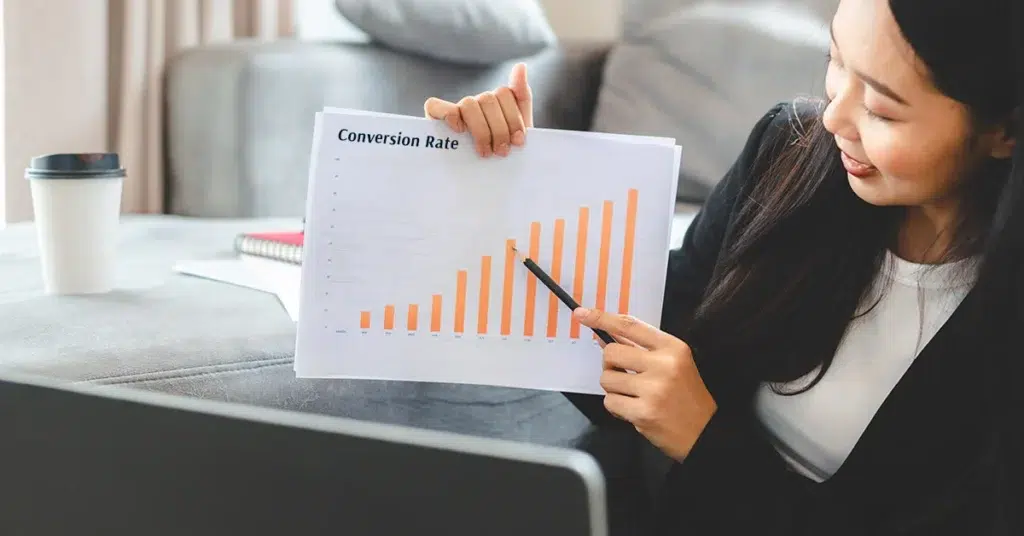
Enhancing website performance is crucial in the digital realm. Conversion Rate Optimization (CRO) plays a pivotal role in boosting conversions and user engagement by focusing on optimizing the site’s conversion rate. Recognizing the significance of CRO is paramount for digital marketers seeking to maximise results.
Understanding the average conversion rate in various industries is essential to set benchmarks and goals for CRO.
Introducing Machine Learning (ML) into this mix revolutionises CRO and sales efforts, offering unparalleled insights and precision. This blog will delve into the synergy between CRO and ML, providing actionable strategies for optimal outcomes.
Understanding Conversion Rate Optimization

Enhancing the performance of a website is vital in the digital landscape, and focusing on website conversion rates is crucial for online business success. Conversion Rate Optimization (CRO) is at the core of this enhancement in web design, focusing on increasing conversion rates and engaging users effectively.
Optimizing various elements on a website can significantly improve the website conversion rate. Understanding the fundamental aspects of CRO is key to its successful implementation.
Definition and Importance of CRO
Conversion Rate Optimization (CRO) is the systematic process of increasing the percentage of website visitors who complete a desired action, such as filling out a form, making a purchase, or subscribing to a newsletter.
This process is crucial for businesses as it helps to maximize the value of their website traffic, increase revenue, and improve the overall user experience. By focusing on CRO, businesses can ensure that their website is not just attracting visitors but also converting them into customers or leads.
This involves analyzing user behavior, identifying barriers to conversion, and implementing strategies to overcome these obstacles. Effective CRO can lead to significant improvements in a website’s conversion rate, ultimately driving more revenue and enhancing user satisfaction.
Basics of Conversion Rate Optimization
Key Metrics in CRO
To excel in CRO, one must grasp the essential key metrics that drive success. Metrics such as bounce rate, click-through rate, and conversion funnel traffic analysis are pivotal in gauging user interaction and identifying areas for improvement.
Among these metrics, understanding average conversion rates is crucial for providing specific statistical benchmarks in different sectors, helping to inform better decision-making for improving online conversions. The site’s conversion rate is crucial for understanding how well your website is converting visitors into customers.
Common CRO strategies
Implementing effective CRO strategies is imperative for boosting conversions. Tactics like creating compelling CTAs, optimising landing pages, and conducting A/B tests play a significant role in enhancing user experience and driving leads to desired actions.
Split testing is crucial in evaluating variations of web content to enhance user engagement and sales. Effective CRO strategies are essential for improving website conversion rates and driving desired actions from website visitors.
Challenges in Traditional CRO
Limitations of Manual Analysis
Traditional methods often face challenges due to the limitations of manual analysis. Manual processes can be time-consuming and prone to errors, hindering the efficiency of CRO initiatives.
Difficulty in Personalisation
Personalization is a crucial aspect of successful CRO, yet it poses challenges in traditional approaches. Tailoring content and service out to individual user preferences requires advanced techniques that go beyond conventional practices.
Selecting the right conversion optimization tools is essential to effectively enhance conversion rates and achieve personalization.
Introduction to Machine Learning

Machine Learning (ML) is a cutting-edge technology that empowers businesses to unlock valuable insights and drive strategic decisions. Understanding the core principles of ML is essential for leveraging its potential in digital marketing.
What is Machine Learning?
Machine Learning encompasses diverse methodologies, including Supervised, Unsupervised, and Reinforcement learning. These approaches enable algorithms to learn patterns from data, enhancing decision-making processes.
Types of Machine Learning (Supervised, Unsupervised, Reinforcement)
Supervised Learning: In this method, algorithms are trained on labelled data to predict outcomes accurately.
Unsupervised Learning: Algorithms uncover hidden patterns within unlabelled data, offering valuable insights for segmentation and clustering.
Reinforcement Learning: This approach focuses on decision-making through trial and error, optimising strategies based on feedback mechanisms.
Key Algorithms Used in ML
Linear Regression
Decision Trees
Random Forest
Support Vector Machines
Applications of ML in Digital Marketing
The integration of Machine Learning (ML) in digital marketing revolutionizes how businesses engage with their audience, create, and drive conversions effectively.
To enhance user experiences specifically for mobile devices, it is crucial to focus on strategies such as improving page layouts and load times.
Predictive Analytics
Predictive analytics leverages historical data to forecast future trends accurately. By analysing customer behaviour patterns, businesses can anticipate needs and tailor marketing strategies accordingly.
Customer Segmentation
Customer segmentation divides the target audience into distinct groups based on shared characteristics. ML algorithms identify common traits among customers, enabling personalised marketing campaigns tailored to specific segments.
Integrating Machine Learning with Conversion Rate Optimization Strategies (CRO)

Benefits of Using ML for Conversion Marketing Tactics
Enhancing Conversion Rate Optimization (CRO) with Machine Learning (ML) offers unparalleled advantages. By leveraging ML techniques, businesses can achieve improved accuracy in data analysis, leading to more precise insights for optimising conversion rates.
Implementing effective strategies with ML, such as offering discounts through pop-ups, can lead to increased conversions and repeat business. Additionally, the integration of ML enables enhanced personalisation, allowing for tailored user experiences that drive higher engagement and can increase conversions further.
ML techniques for CRO User Experience
Implementing Machine Learning (ML) techniques in Conversion Rate Optimization (CRO) strategies elevates the optimization process to new heights. A/B testing with ML enhances the efficiency of testing variations by providing statistically significant results quickly.
Predictive modelling empowers businesses to forecast user behaviour accurately, enabling proactive adjustments to improve conversion rates. Moreover, personalised search engine recommendations based on ML algorithms cater to individual user preferences, increasing the likelihood of conversions through targeted content.
Tools and Platforms
When it comes to integrating Machine Learning with Conversion Rate Optimization, utilising the right tools and platforms is essential for success. Popular ML tools designed specifically for CRO, such as Google Analytics and other advanced analytics platforms, provide valuable insights into user behaviour and conversion patterns.
Selecting the right conversion optimization tools is crucial to effectively enhance conversion rates. Careful budget allocation and evaluation of return on investment (ROI) when investing in these tools can significantly improve user experience and foster customer loyalty.
Exploring case studies of successful ML-CRO integration showcases real-world applications and highlights the tangible benefits that businesses have experienced through this synergy.
Conversion Rate Optimization Process
The CRO process involves a series of steps that help businesses to identify areas for improvement, develop hypotheses, and test solutions to increase conversions. This structured approach ensures that every change made to the website is based on data and insights, leading to more effective and sustainable results.
Research Phase
The research phase is the foundation of the CRO process. It involves gathering data and insights about website visitors, their behavior, and their interactions with the website. This phase helps businesses to identify pain points, opportunities for improvement, and areas that require optimization. By understanding how users navigate the site, where they drop off, and what elements they engage with, businesses can make informed decisions about where to focus their optimization efforts.
Hypothesis Phase
The hypothesis phase involves developing educated guesses about the changes that can be made to the website to improve conversions. These hypotheses are based on the data and insights gathered during the research phase.
Businesses can use tools like heatmaps, session recordings, and user feedback to inform their hypotheses. For example, if data shows that users are abandoning their shopping carts at a specific point, a hypothesis might be that simplifying the checkout process will increase conversions.
Prioritization Phase
The prioritization phase involves evaluating and prioritizing the hypotheses developed during the hypothesis phase. Businesses can use frameworks like the PIE framework to prioritize their hypotheses based on their potential impact, importance, and ease of implementation.
This ensures that the most promising and feasible changes are tested first, maximizing the chances of achieving significant improvements in conversion rates. By systematically prioritizing and testing hypotheses, businesses can continuously optimize their websites and drive better results.
Practical Tips for Implementing ML in CRO Testing

Getting Started with ML
Setting Clear Goals
Initiate the journey of ML implementation by establishing clear objectives that align with your CRO plan. Define specific targets to guide your efforts towards enhancing conversion rates effectively. By outlining precise goals, you pave the way for a focused and strategic approach to leveraging Machine Learning in your optimization strategies.
Choosing the Right Tools
Selecting the appropriate tools is paramount in ensuring the success of your ML-CRO integration. Evaluate various ML platforms and technologies to identify the ones that best complement your existing infrastructure and objectives. By opting for tools tailored to your needs, you equip yourself with the necessary resources to streamline data analysis, testing procedures, and personalization efforts effectively.
Best Practices in Implement CRO Strategies
Continuous Testing and Getting the Average Conversion Rate
Embrace a culture of continuous testing within your CRO framework to refine strategies and enhance user experiences consistently. By making testing an ongoing priority, you can identify areas for improvement, validate hypotheses, and implement data-driven optimizations that resonate with your target audience.
Continuous testing and optimization practices are crucial for increasing conversions, as they help you understand customer behavior and refine their experience to encourage desired actions on your website.
Through iterative testing cycles, you can uncover valuable insights that lead to incremental improvements in conversion rates over time.
Monitoring and Adjusting Strategies for Website Visitors
Vigilant monitoring of key performance indicators (KPIs) is essential for gauging the effectiveness of your ML-powered CRO initiatives. Regularly track metrics related to user engagement, conversion funnels, and A/B test results to gain actionable insights into performance trends.
Based on these observations, be prepared to adjust strategies promptly, capitalise on successful outcomes, and address any underperforming elements proactively. By maintaining a proactive stance towards strategy adjustments, you can maximise the impact of Machine Learning on your own conversion rate optimisation and optimization efforts.
CRO and Website Integration Strategies

The Impact that it Brings to Website Visitors
Optimising the integration of Conversion Rate Optimization (CRO) with websites and services yields substantial benefits. By aligning CRO strategies with website functionalities, businesses can maximise their Return of Investments (ROI) and enhance customers’ benefits significantly.
Return of Investments
Enhancing conversion rates through effective CRO techniques directly impacts the ROI of a business.
Improved user engagement and streamlined conversion processes lead to increased revenue generation.
By focusing on enhancing user experience, businesses can witness a notable boost in their ROI metrics.
Customers Benefits
Tailoring website experiences based on customer preferences enhances satisfaction levels.
Personalised recommendations and seamless navigation contribute to a positive user experience.
Prioritising customer-centric design elements fosters loyalty and encourages repeat interactions.
Best Practise to Increase Conversion Rates
Implementing optimal optimisation strategies is crucial for successful CRO and website integration. By prioritising strategic approaches and diligent monitoring practices, businesses can optimize and elevate their digital presence effectively. By implementing these best practices, businesses can significantly improve their website conversion rates.
Optimisation Strategies
Conduct regular audits to identify areas for improvement within the website structure.
Implement responsive design elements to ensure seamless user experiences across devices.
Optimize specific web pages to enhance user experience and drive conversions.
Leverage data analytics to refine content strategies and enhance engagement levels.
Tracking and Monitoring
Utilise advanced tracking tools to monitor user behaviour patterns and identify conversion bottlenecks.
Establish key performance indicators (KPIs) to measure the effectiveness of CRO initiatives accurately and timely manner.
Regularly analyse website performance metrics to adapt strategies proactively based on real-time insights.
Enhancing CRO with Advanced Techniques

Conversion rate optimization (CRO) is a crucial aspect of digital marketing that helps online businesses boost conversions and user engagement. To take CRO to the next level, it’s essential to incorporate advanced techniques that can help you better understand your target audience, optimize your website, and improve your conversion rates.
User Experience (UX) Design
User experience (UX) design plays a vital role in CRO. A well-designed website can enhance user engagement, reduce bounce rates, and increase conversions. To create a positive user experience, focus on the following key elements:
Intuitive navigation: Make it easy for website visitors to find what they’re looking for.
Clear and concise content: Use simple language and avoid jargon.
Visual hierarchy: Use headings, subheadings, and whitespace to create a clear visual flow.
Responsive design: Ensure your website is optimized for various devices and screen sizes.
Optimizing specific elements on a web page, such as UX copy and call-to-action buttons, can significantly improve engagement and conversion metrics.
By incorporating these UX design principles, you can create a website that is both user-friendly and conversion-friendly, ultimately leading to a positive user experience and higher engagement.
A/B Testing and Experimentation
A/B testing and experimentation are essential components of CRO. By testing different versions of your website, you can determine which elements are most effective at driving conversions. Designing and testing landing pages is crucial to enhance user experience and drive conversions, as a well-optimized landing page serves as the first impression for visitors and is essential for achieving marketing goals. Here are some tips for A/B testing:
Test one element at a time: Avoid testing multiple elements simultaneously, as this can make it difficult to determine which element is responsible for the change in conversions.
Use a large enough sample size: Ensure you have a sufficient number of website visitors to make the test statistically significant.
Test for a long enough period: Run the test for a long enough period to account for any fluctuations in website traffic.
By incorporating A/B testing and experimentation into your CRO strategy, you can make data-driven decisions and optimize your website for maximum conversions impact.
Call-to-Actions (CTAs) and Conversion Optimization
Call-to-actions (CTAs) are a critical component of CRO. A well-designed CTA can encourage website visitors to take the desired action and increase conversions. Effective CTAs can convert visitors into paying customers by guiding them through the sales funnel. Here are some tips for optimizing your CTAs:
Use action-oriented language: Use verbs like “Sign up,” “Download,” or “Buy now” to encourage website visitors to take action.
Make it prominent: Place your CTA in a prominent location on your website, such as above the fold or in a sidebar.
Use contrasting colors: Use colors that contrast with the rest of your website to make your CTA stand out.
By optimizing your CTAs, you can increase conversions and drive more revenue for your online business.
Optimizing Website Traffic for CRO
Optimizing website traffic is essential for CRO. By driving high-quality traffic to your website, you can increase conversions and drive more revenue. Improving your website’s conversion rate through targeted traffic and optimization strategies is crucial. Here are some tips for optimizing website traffic:
Use search engine optimization (SEO) techniques: Optimize your website for relevant keywords to drive organic traffic.
Use paid advertising: Use paid advertising channels like Google Ads or Facebook Ads to drive targeted traffic to your website.
Use social media: Use social media platforms to drive traffic to your website and increase brand awareness.
By optimizing website traffic, you can increase conversions and drive more revenue for your online business.
By incorporating these advanced techniques into your CRO strategy, you can take your conversion rate optimization to the next level and drive more revenue for your online business.
Final Thoughts
Recapping the pivotal insights uncovered, Conversion Rate Optimization (CRO) stands as a cornerstone for enhancing user engagement and driving conversions effectively. The future landscape of CRO with Machine Learning (ML) promises unparalleled precision and strategic advancements.





